| Conservation of the 'Moat' Section |

|
The 'Moat' segment is located in the northern wall of the Old City, east of Damascus Gate. The entrance to Zedekiah's Cave is situated in the western part of the 'Moat' segment. This section of the city wall was built above a steep rock-hewn moat that is part of the fortification. Nine towers, some of which are decorated, reflect the strategic vulnerability of this region. The Flower Gate, which is today used mostly by local residents, is fixed in the middle of the segment.
Physical Data
Remains of the city's fortifications were discovered along the eastern slope of the hill and include a section of a wall, a gate and a tower that are probably the "spring gate" (eighteenth century BCE). Finds from the early periods, especially from the Canaanite-Jebusite phase prior to the conquest of the city by David (Late Bronze Age, fifteenth-thirteenth centuries BCE), were discovered in Yigal Shiloh's excavations at the City of David and before that in Kathleen Kenyon's excavations.
Values for Conservation
Historical Values. The northeastern wall of the Old City has been mentioned over the course of history because it was the weakest point in the system of fortifications and it was through this segment of the wall that the Crusaders and Ayyubids conquered the city. The moat, which was first hewn in the Crusader period, followed the route of Nahal Bizita and encircled the wall to the north and east. The moat is also visible today in the exposed bedrock at the base of the wall, and it is proof of the need for defenses in this spot (Fig. 1).
At first the Flower Gate was a modest structure that was fixed in the eastern side of the wall, without an inner tower. Modifications were made to the gate from second half of the nineteenth century. This is the only one of the city's gates where there is later construction on the inside of the city wall, even though at the time of the British Mandate later building additions were removed from the gates.
It seems that the complex development of the gate structure is related to the failed initial planning that did not provide easy access to the outer gate tower. This fact led to the construction of the inner tower, in the wake of which the free flow of movement in the upper sentry was blocked. Uninterrupted movement was restored there at the time of the British Mandate by means of a modern iron staircase; however, this intervention destroyed the firing slit and the crenellation on the gate's eastern facade (Figs. 2, 3).
Urban Value. The entrance to Zedekiah's Cave and the Flower Gate are important urban centers in this segment of the wall. The entrance to the cave, which was exposed in 1854, is fixed in the bedrock west of Damascus Gate, close to the spot where the moat begins. The Flower Gate, which was set in the eastern side of the city, was constructed as a postern, and since then it has been used mainly as a passage by those residing in the northeastern region of the Old City.
Landscape Value. The northeastern city wall is characterized first and foremost by the bedrock that is apparent at the bottom of the courses of the Ottoman city wall. In certain sections of the wall the overall height of the stone courses is equal to the height of the bedrock and is even higher, such that the bedrock and wall actually constitute a single unit of the city's defenses.
Architectural Value. Remains of the Umayyad wall are visible at the foot of the Ottoman wall, east of the Flower Gate. The large dimensions and crude stone dressing of the courses of this city wall standout prominently in contrast to the courses of the Ottoman wall. The sequence of towers and the regular intervals between them reflect not only the architectural quality of the fortification but also the need for massive defenses from this direction (Fig. 4). Some of the towers are adorned with inscriptions and medallions and are well-preserved.
The Flower Gate is a secondary gate in the northern city wall. This fact is evidenced by its diminutive size compared to Damascus Gate. The numerous changes the gate underwent are apparent in most of its facades. There is a tower that was built on the inside of the city wall in a late phase, of relatively smaller stones than those used in the Ottoman wall. An iron staircase that was assembled at the end of the Ottoman period is visible in the southern facade. In order to install the staircase a firing slit whose remains are visible in the facade was destroyed. At the beginning of the twentieth century an entrance was breached in the northern facade of the outer gate tower. This breakthrough, which allowed direct and convenient entry to the city, is silent testimony to the exodus from the confines of the city walls and the decline in their importance as a line of defense.
Physical Problems
The moat wall is founded on bedrock and in certain sections on the remains of an older wall. The bedrock is undergoing a process of disintegration, whereby crumbling and detachment are apparent in it. One can see that stones and mortar are missing in the ancient, built remains. The preservation of the built wall is good; its outline is mostly intact except in some of the towers. In the Flower Gate the level of the roof has subsided due to the penetration of water and vegetation taking root in it, which have resulted in cracking. Neglect is clearly evident in the gate's interior and in the courtyard above the inner tower. In addition, infrastructure wires have been installed incorrectly on the inner facade of the gate.
The Conservation Issue
The Flower Gate has undergone numerous changes throughout history. Modifications were made to the original Ottoman gate structure and later building additions were installed. An iron staircase was installed on the eastern facade, which did indeed renew the continuity of the ramparts promenade, but also caused damage to the eastern firing slit and the crenellation above it. In conserving the gate it was decided to emphasize the historical value embodied in the physical changes it has undergone. The marks connecting the soldier's compartment to the facade, which were blurred, were preserved and highlighted.
The moat wall is characterized by more or less regular intervals of towers and wall sections. One can assume that the frequency of the towers relates to the fact that this region was the most vulnerable point in the city's defenses. Since the towers are of historical importance and have an architectural presence, it was decided to emphasize that presence by means of completing the stone work in their crenellations. In order to emphasize the architectural value of wall the crenellations were completed in the section just east of the Flower Gate because of its high degree of visibility.
The Conservation Measures
1. Stabilizing the Remains of an Ancient Wall. Stabilizing the courses from the Byzantine and Umayyad periods included: removing vegetation, filling in cavities between the bedrock and the base of the wall with mortar and stone wedges; pointing up the joints with lime-based mortar and inserting pieces of stones in the joints between the stones.
2. Completing the Stone Work. The stone work was completed in a few places, primarily in the tower crenellations. This was meant to underscore the architectural value of the skyline and was not intended for constructive purposes (Figs. 5-8).
Conservation of the Flower Gate
The Roof Level. The vegetation that took root caused cracking in the crenellation and the stone staircase. The crenellation and the upper course of the staircase were dismantled and rebuilt with the original stones after the vegetation was cleaned.
The Inner Facade. The infrastructures were removed from the facade. Some of them were installed below the pavement and some were installed in a compact fashion at the side of the gate's inner facade (Figs. 9, 10).
The Interior of the Gate. Steam was used to clean stains on the stone. A cracked lintel stone inside the gate tower's interior cavity was replaced with a new stone. Vegetation that took root in the pavement on this tower's second level was removed and a new pavement was installed.
Soldier's Compartment. The soldier's compartment in the tower's southern facade was removed in the nineteenth century CE. Marks indicating its outline were highlighted; later additions and cement were removed (Figs. 11, 12).
Sources:
Library of Congress of the United States of America, Matson Collection, http://www.loc.gov/pictures
Israel Antiquities Authority Archives: British Mandate Folder: File No. 79, Jerusalem City Walls and Collections.
Shiller Eli, 1978. First Photographs of Jerusalem: The Old City. Jerusalem: Ariel.
|
|
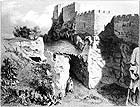
|
| 1. View looking east toward the moat near Zedekiah's Cave. 1841. Tipping. Palestine Exploration Fund. |
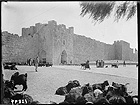
|
| 2. The Flower Gate at the time of the British Mandate, following intervention. The sheep and goat market is in front of the gate. 1925-1940. Matson Collection. |
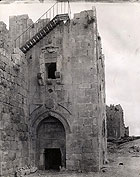
|
| 3. The iron staircase, looking toward the eastern facade of the gate. 1925. IAA Archives. |
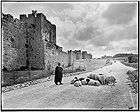
|
| 4. The regular interval of the towers, looking west toward the moat wall. Beginning of the twentieth century. Matson Collection. |
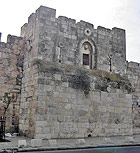
|
| 5. Tower 8: the northern facade before intervention, 2008. Photograph: Yuval Abraham. |
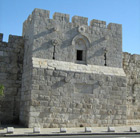
|
| 6. Tower 8: the northern facade after intervention, 2008. Photograph: Avi Mashiah. |
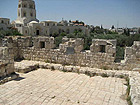
|
| 7. Tower 1: crenellations prior to intervention, 2008. Photograph: Yuval Abraham. |
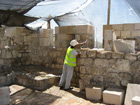
|
| 8. Tower 1: completion of the stone work in the crenellations 2008. Photograph: Avi Mashiah. |
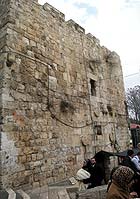
|
| 9. The Flower Gate: the inner facade facing south, prior to intervention, 2008. Photograph: Yuval Abraham. |
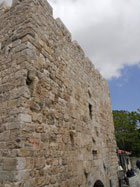
|
| 10. The Flower Gate: the inner facade facing south, after intervention, 2009. Photograph: Avi Mashiah. |
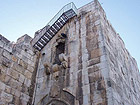
|
| 11. The Flower Gate: the firing slit prior to intervention, 2008. Photograph: Yuval Abraham. |
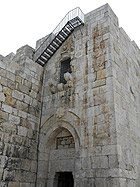
|
| 12. The Flower Gate: the firing slit after intervention, 2009. Photograph: Avi Mashiah. |
|















